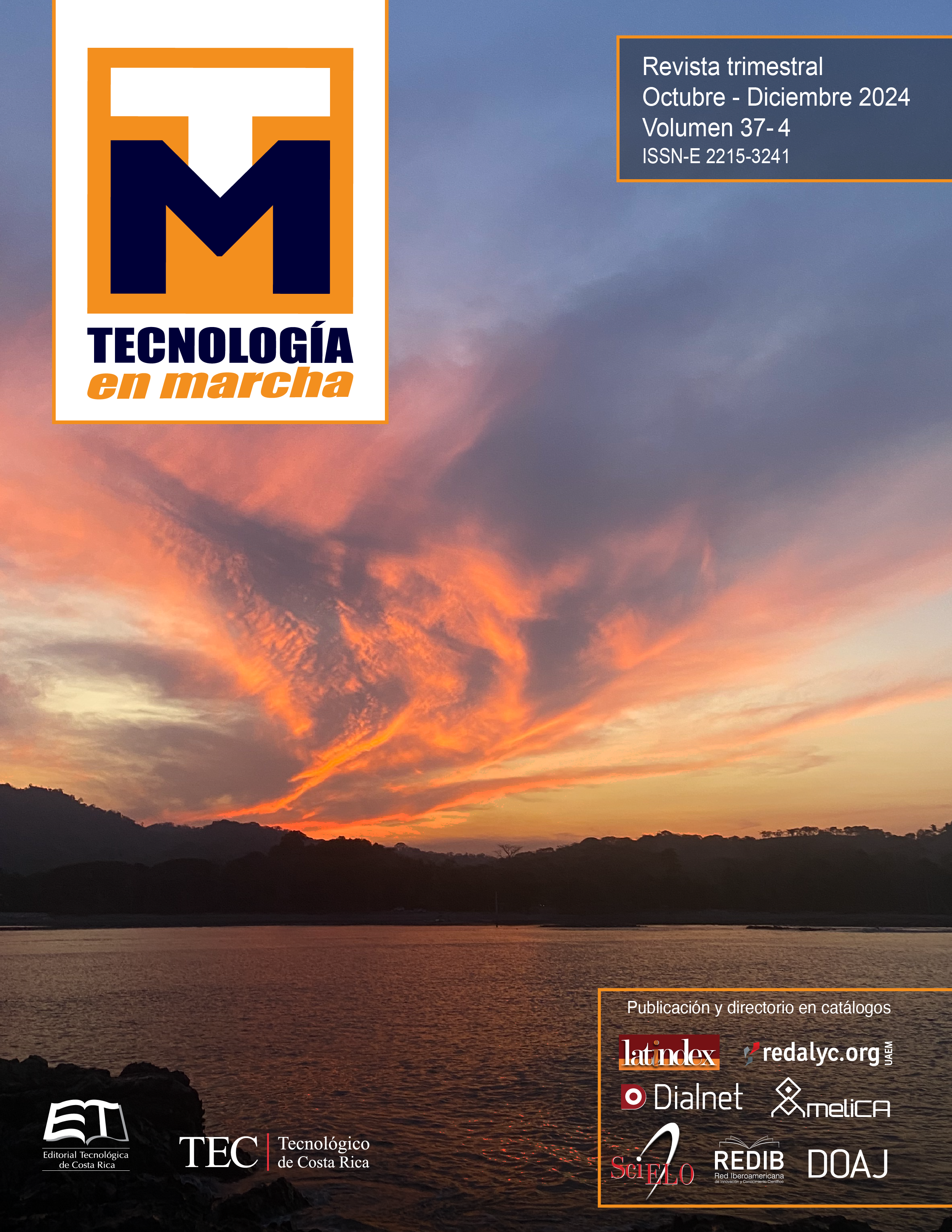Utilización de arenas comerciales en materiales de concreto hidrofobizados
Contenido principal del artículo
Resumen
El concreto hidráulico es uno de los materiales de construcción más empleados debido a la ubicuidad de sus precursores: agua, cemento, agregados finos y gruesos. Uno de los agregados principales es la arena, sin embargo, no todas las arenas disponibles cumplen los requisitos de idoneidad, pureza, graduación, forma y porosidad. Algunas soluciones para el mejoramiento de arenas para su uso en la fabricación de concreto hidráulico son la combinación de agregados finos, uso de aditivos, alternativas de reemplazo e incremento en la cantidad de cemento, entre otras posibilidades remediales. Este artículo describe la formulación de materiales de concreto hidrofóbicos con tres tipos de arenas (con porosidades, granulometrías y finuras diferenciadas entre sí). La hidrofobización del concreto se realiza al incorporar partículas de sílices modificadas químicamente y se estudia la interacción de estas partículas con las diferentes arenas. Se confirmó que la graduación y la porosidad de los agregados finos seleccionados influye en la absorción de agua de las matrices de concreto, sin embargo, se logra una mejora de más del 30% en la hidrofobicidad de la matriz al agregar sílice hidrofóbica.
Detalles del artículo

Esta obra está bajo una licencia internacional Creative Commons Atribución-NoComercial-SinDerivadas 4.0.
Los autores conservan los derechos de autor y ceden a la revista el derecho de la primera publicación y pueda editarlo, reproducirlo, distribuirlo, exhibirlo y comunicarlo en el país y en el extranjero mediante medios impresos y electrónicos. Asimismo, asumen el compromiso sobre cualquier litigio o reclamación relacionada con derechos de propiedad intelectual, exonerando de responsabilidad a la Editorial Tecnológica de Costa Rica. Además, se establece que los autores pueden realizar otros acuerdos contractuales independientes y adicionales para la distribución no exclusiva de la versión del artículo publicado en esta revista (p. ej., incluirlo en un repositorio institucional o publicarlo en un libro) siempre que indiquen claramente que el trabajo se publicó por primera vez en esta revista.
Citas
S. Mindess, Developments in the Formulation and Reinforcement of Concrete. Kidlington, UK: Elsevier, 2019.
Y. Ding and X. Ning, Reinforced Concrete. Beijing, China: Springer, 2022.
A. Surahyo. Concrete Construction. Cham, Switzerland: Springer, 2019.
W. Yang, The Issues and Discussion of Modern Concrete Science. Berlin, Germany: Springer, 2015.
K. Janamian and J. Aguiar, Concrete Materials and Technology. London, UK: CRC Press, 2023.
Z. Jiang, High-Performance Concrete with Manufactured Sand. Singapore, Singapore: Springer, 2023.
G. de Schutter and K. Lesage, Active Rheology Control of Cementitious Materials. Oxford, UK: CRC Press, 2023.
G. Gaganelis, P. Mark, P. Forman, Optimization Aided Design. Berlin: Germany, Wilhelm Ernst & Sohn, 2022.
P. Hewlett, M. Liska, Lea´s Chemistry of Cement and Concrete. London, UK: Elsevier, 2019.
A. Chaubey. Practical Concrete Mix Design. CR Press. New York, NY: 2020.
R. Torrent, R. Neves, K. Imamoto, Concrete Permeability and Durability Performance. London, UK: CRC Press, 2022.
Z. Li, X. Zhou, H. Ma, D. Hou, Advanced Concrete Technology. Hoboken, NJ: Wiley, 2023.
S. Kosmatka, M. Wilson, Design and Control of Concrete Mixtures. Skokie, IL: PCA, 2016.
A. Moulay-Alia, M. Abdeldjalila M., H. Khelafib, “An experimental study on the optimal compositions of ordinary concrete based on corrected dune sand—Case of granular range of 25 mm. Case Studies in Construction,” Materials, Vol.14, pp. 1-12, 2021. DOI: https://doi.org/10.1016/j.cscm.2021.e00521.
M. Gou, B. Hu, F. Xing, X. Zhou, M. Sun, L. Sui, Y. Zhou, “Characterization of mechanical properties of eco-friendly concrete made with untreated sand and seawater based on statistical analysis. water absorption in concrete materials by modification with hybrid hydrophobic silica particles,” Construction and Building Materials, Vol.234, pp. 1-12, 2020. DOI: https://doi.org/10.1016/ j.conbuildmat.2019.117339.
J. Kaufmann, “Evaluation of the combination of desert sand and calcium sulfoaluminate cement for the production of concrete,” Construction and Building Materials, Vol.221, pp. 210-218, 2020. DOI: https://doi.org/10.1016/j.conbuildmat.2020.118281.
Z. Steyn, A. Babufem, H. Fataar, R. Combrinck, “Concrete containing waste glass, plastic and rubber as sand replacement,” Construction and Building Materials, Vol.269, pp. 1-9, 2021. DOI: https://doi.org/10.1016/j.jobe.2021.121242.
E. Mora, G. González, P. Romero, E. Castellón, “Control of water absorption in concrete materials by modification with hybrid hydrophobic silica particles,” Construction and Building Materials, Vol.221, pp. 210–218, 2019. DOI:https://doi.org/10.1016/ j.conbuildmat.2019.06.086.
ASTM (American Society for Testing and Materials), Standard Specification for Concrete Aggregates ASTM International. West Conshohocken PA, ASTM C33/C33M-18, 2018.
ASTM (American Society for Testing and Materials). Standard Test Method for Relative Density (Specific Gravity) and Absorption of Fine Aggregate. ASTM International. West Conshohocken PA, ASTM C128-15, 2015.
P. Schneider, “Adsorption isotherms of microporous-mesoporous solids revisited,” Appl. Catal. A: General, Vol.129, pp. 157–165, 1995. DOI: https://doi.org/10.1016/0926-860X(95)00110-7.
ASTM (American Society for Testing and Materials). Standard Test Method for Compressive Strength of Hydraulic Cement Mortars (Using 2-in. or [50-mm] Cube Specimens). ASTM International. West Conshohocken PA, ASTM C109/C109M-16a, 2020.
E. Mora, F. Castellón, “Anti-adherent molds yield hydraulic concrete samples suitable for assessments of surface and water absorption,” Journal of Civil Engineering and Construction, Vol.10 No4, pp. 245-252, 2021. DOI: https://doi.org/10.32732/jcec.2021.10.4.245.
A. Stalder, G. Kulik, D. Sage, L. Barbieri, P. Hoffmann, “A snake-based approach to accurate determination of both contact points and contact angles,” Colloid, Surface, Vol. 286, pp.92–103, 2006. DOI:10.1016/j.colsurfa.2006.03.008.
K. Walton and R. Snurr, “Applicability of BET Method for Determining Surface Areas of Microporous Metal-Organic Frameworks,” J. Am. Chem. Soc, Vol. 129, No27, pp. 852–856. 2007. DOI:https://doi.org/10.1021/ja071174k).
H. Kibler, K. Carter. “Langmuir-type model for anomalous moisture diffusion in composite resins”. Journal Composite Materials Vol. 12 No 118, pp. 118-131. 1978. DOI:https://doi.org/10.1177/ 002199837801200201.

